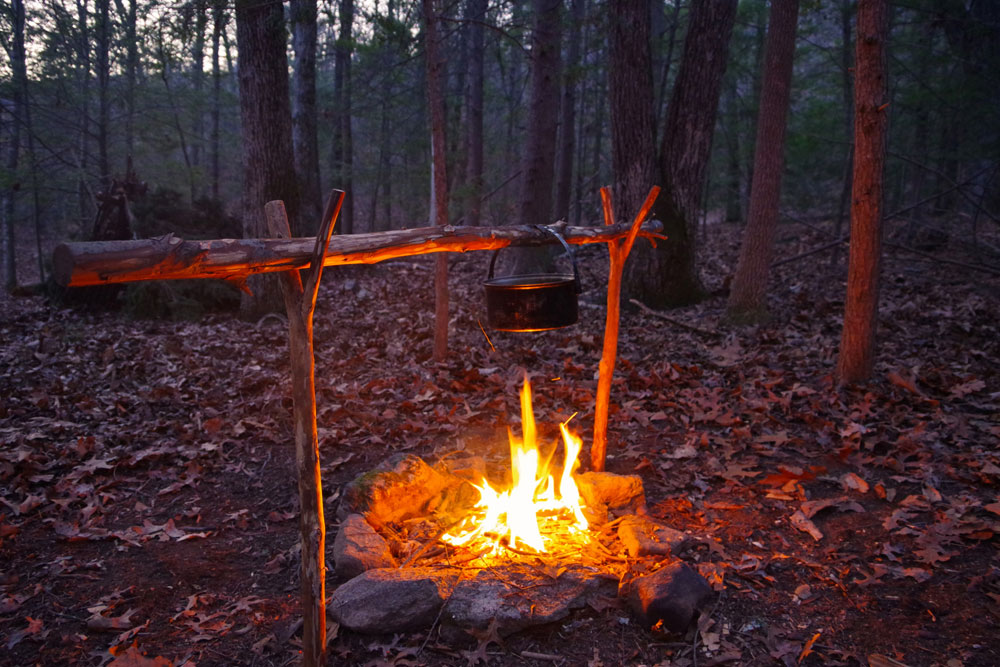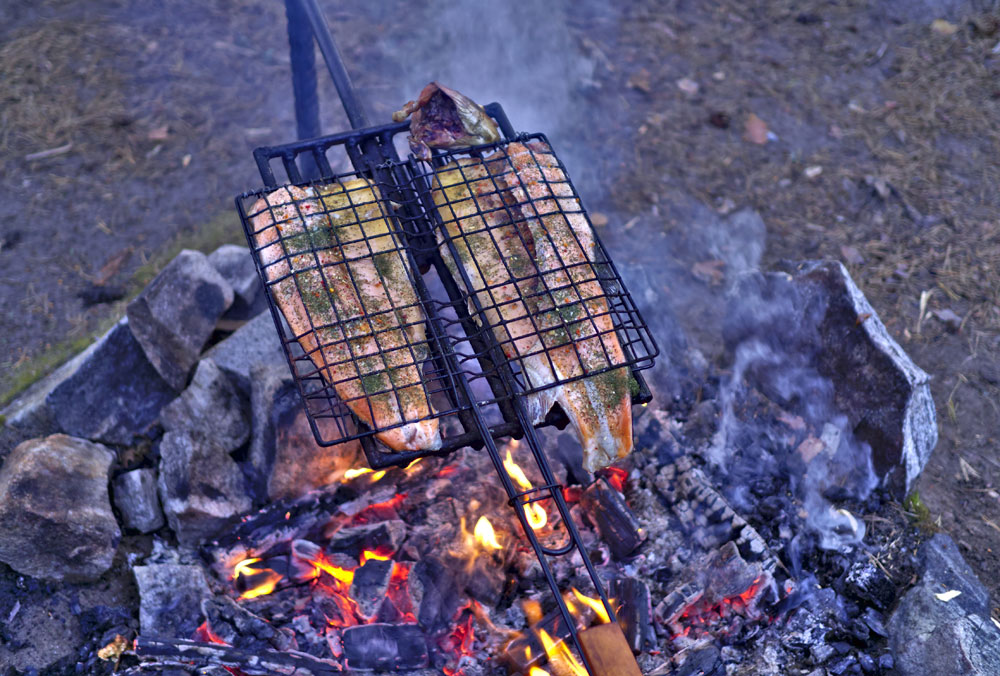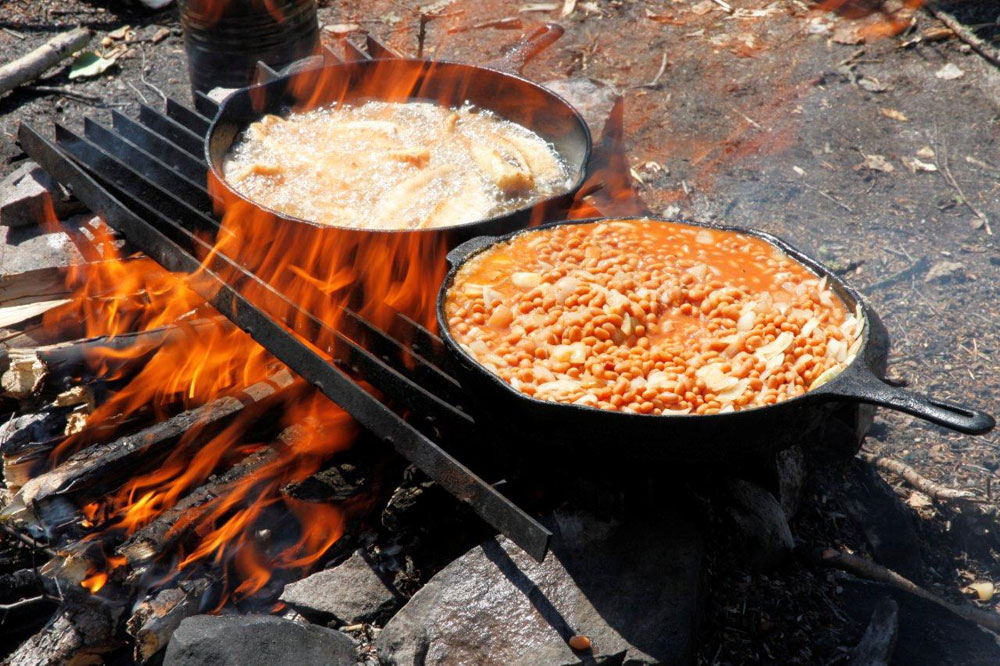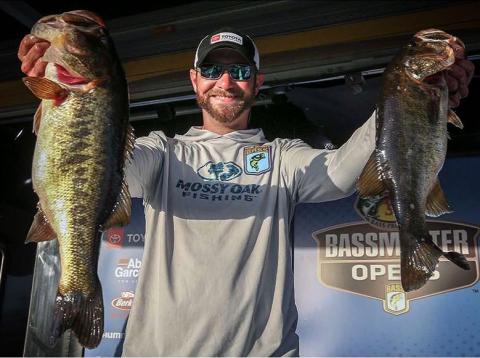Is there anything more relaxing than cooking over an open campfire? The natural wood smoke imparts an incredible flavor to any dish, while the soft crackle of flames makes campfire cooking a soothing way to enjoy the great outdoors. To get the best out of your camping experience, there are a few tips and tricks when cooking food over a campfire.

1. Build Your Fire Correctly
To cook food correctly, you need the perfect campfire. Building a campfire involves burning plenty of wood until there are red hot coals to deliver even cooking. To build a fire correctly, there are several factors you should consider:
- Wood
Wood for a campfire should burn slowly and evenly. Oak and hickory are popular options. However, if you aren’t planning to take wood with you camping, ash is a great alternative and can be easily sourced at your campsite.
- Location
Select a safe location to build your campfire, preferably in a pre-dug fire pit. The site should be sheltered from the wind and free from grass, leaves, and other debris.
- Clearance
Also, make sure there are no trees or power lines overhead. It is recommended that you have 10 feet of clearance on every side of the fire. Form a perimeter around the fire with green wood or rocks to prevent it from spreading. A large rock at the rear of the fire site can act as a chimney to funnel away smoke.
Start laying down tinder, such as a crumpled-up newspaper or dry grass, and pile thin twigs or dry branches in a vertical conical shape on top of the tinder. Light the tinder, and then add larger dry branches as the small ones catch alight. Begin to add your firewood over the kindling and let it burn until you are left with white coals. This may take between 45 minutes to an hour.
2. Use the Right Gear

The possibilities are endless when it comes to campfire recipes, but you need to have the right tools for the job to create delicious dishes.
A grill grate is an excellent choice for a cooking surface. You can grill meat and vegetables directly on the grate or use it as a stand to hold pots and pans for boiling water, frying, or slow cooking.
Cast iron cookware is recommended for campfire cooking as the dense metal retains heat better and distributes it more evenly. Some cast iron essentials include a cast iron pot, skillet, and a dutch oven.
Don’t forget utensils such as stainless steel tongs and a long-handled spoon for stirring and serving. You will also need safety and cleaning gear such as grill gloves, a wire grill brush, and a digital meat thermometer.
3. Don’t Forget the Aluminum Foil
This multipurpose item can be used to line cookware, wrap fruits and vegetables for cooking directly in the coals, and make parcels for gently cooking protein. In a pinch, you can even mold it to form a basic pot or serving bowl.
4. Do the Food Prep at Home
For easy cooking, do as much of the food prep work as possible at home. Slicing and dicing meat and vegetables is simpler at home when all your utensils are in easy reach. Put your ingredients in storage containers and bring them along with you.
Store cold produce such as meat and dairy in a cooler packed with ice bricks to maintain freshness. Alternatively, vacuum seal your produce at home to keep it fresher for longer.
5. Do Not Cook Directly over Naked Flames
The only thing that cooking directly over flames will achieve is burnt food. The intense heat chars the exterior of your meat or cooks dishes unevenly, which is not only unappetizing but also unsafe. Wait until your coals are white-hot and use a cooking surface or stand to keep your cookware above the most intense heat.

6. Choose the Right Cooking Method
There are many ways to cook over a campfire, but the cooking method and cookware you need to bring with you depend on what recipe you are planning to make. If you are hunting and plan on cooking wild game, bring along your cast iron cookware for low, slow cooking such as braises or stews.
However, if you just want to roast some hot dogs or make s’mores, then there is no need to carry a heavy cast iron skillet; a few long skewers or a grill grate are sufficient.
Some campfire recipes rely on directly immersing ingredients in the coals, such as campfire baked potatoes or stuffed roasted apples.
7. Use a Spray Bottle to Dampen Flare-Ups
Oil and grease splatters from cooking can easily ignite sparks that can lead to flare-ups. Flare-ups can also alter the heat distribution in your cookfire, causing your food to cook unevenly.
As soon as you spot a wayward flame or ember, spray it with a few jets of water from a spray bottle to keep your campfire contained.
In some cases, it may be a better idea to avoid cooking foods that are greasy or likely to drip fat. If you must fry your food, use a dutch oven with a low oil level to prevent splatters from occurring.
8. Have Water and Sand Ready
Campfires can quickly get out of control if the wind picks up or they are left unattended. Have a bucket each for water and sand to quickly douse and dampen the flames if they look as though they are spreading.
Also, keep water and sand handy for extinguishing the fire when you are finished. To properly put out your campfire before leaving, add a little water or sand and use a long metal skewer to stir the embers. Continue this process until the fire and coals are completely smothered and cold.
Final Word
Cooking over a campfire is a great way to experience nature and enjoy quality time with friends and family. If you love spending time in the great outdoors and have a passion for cooking, browse our website for more tips, tricks, and delicious wild game recipes.

Need wild game meat for a recipe you've been wanting to try? Check out GameKeeper Butchery. GameKeeper Butchery is dedicated to procuring the finest assortment and highest quality of specialty meats from the United States and around the world. Our commitment is to deliver the safest, freshest and most wholesome products.



























